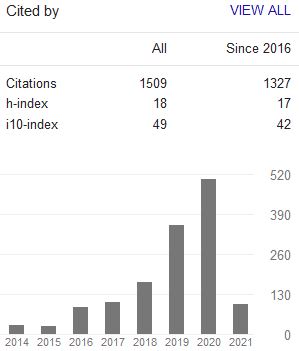CONTEMPORARY RELIGIOUS MOVEMENT IN INDONESIA: A Study of Hijrah Festival in Jakarta in 2018
Abstract
Keywords
Full Text:
PDFReferences
القرأن الكريم
أبو فدا اسماعيل ابن كثير.تفسير ابن كثير، الجزء الرابع، بيروت:دار الكتب العلمية, 1994.
أبوحعفر محمد ابن جرير الطبري. جامع البيان في تفسير أية القران، الطبعة الثالثة، بيروت : دار الفكر, 1998.
As’ad, Isma and Arfan. “My Imam Is My Idol: Muzammil Hasballah and Inhereting Popular Culture in Islamic Tarbiyah Movement in Indonesia.” Identity in the Age of Populism: Southeast Asian Perspectives. Puri Artha Hotel Yogyakarta, 2017.
Bayat, Asef and Linda Herrera. “Introduction: Being Young and Muslim in Neoliberal Times.” Being Young and Muslim: New Cultural Politics in the Global South and North. Oxford: Oxford University Press, n.d.
Cahya, Tunshorin. “Analisis Resepsi Budaya Populer Korea Pada Eternal Jewel Dance Community Yogyakarta” 10, 1 (2016).
Habsari, Sinung Utami Hasri. “Fashion Hijab Dalam Kajian Budaya Populer.” Jurnal PPKM 2, 1 (2015): pp. 126–34.
Hakim, Lukman. “Conservative Islam Turn on or Ppular Islam? An Analysis of the Film Ayat-Ayat Cinta.” Al-Jami‘ah, 48, 1 (2010): pp. 101–28.
Hassan, Noorhaidi. “The Drama of Jihad: The Emergence of Salafi Youth in Indonesia.” Being Young and Muslim: New Cultural Politics in the Global South and North. Oxford: Oxford University Press, 2010.
Heryanto, Ariel. “Budaya Pop Indonesia: Kehangatan Seusai Perang Dingin.” Prisma, 28, 2 (October 2009): 15–30.
---------. Identitas Dan Kenikmatan; Politik Budaya Layar Indonesia. 2nd ed. Jakarta: Kepustakaan Populer Gramedia, 2015.
Hirschkind, Charles and Brian Larkin. “Introduction: Media and the Political Forms of Religion.” Social Text, 26, 3 (2008).
Hoesterey, James B. “Film Islami: Gender, Piety and Pop Culture in Post-Authoritarian Indonesia.” Asian Studies Review, 36 (June 2012): 207–226.
Imam Ardhianto. “Contemporary Islamic Movement, Popular Culture and Public Sphere in Indonesia: The #IndonesiaTanpaJIL Movement.” Archipel, 95, 2018 (June 29, 2018): pp. 151–71. https://doi.org/10.4000/archipel.652.
“Lebih Dekat Dengan Handy ‘Bonny’ Al-Mahmoed.” https://handybonny.wordpress.com/2014/04/02/lebih-dekat-dengan-handy-bonny-al-mahmoed/.
Raharjo Jati, Wasisto. “Islam Populer Sebagai Pencarian Identitas Muslim Kelas Menengah Indonesia.” Teosofi: Jurnal Tasawuf Dan Pemikiran Islam 5, no. 1 (June 2015).
Rani, Mohd. Zariat Abdul. “Islam, Romance and Popular Taste in Indonesia: A Textual Analysis of Ayat-Ayat Cinta by Habiburrahman El-Shirazy and Syahadat Cinta by Taufiqurrahman Al-Azizy.” Indonesia and the Malay World, 40, 116 (March 2012): pp. 59–73.
Said, Muhammad. “Dakwah Virtual, Politik Kesalehan, Dan Demokrasi.” https://geotimes.co.id/opini/dakwah-virtual-politik-kesalehan-dan-demokrasi/?fbclid=IwAR22VX-8u2DD1qJe_Ganvuezcaz-Q6YYvazLc9DxKtsQ8ZGH2NXihZJI1vNM.
Salman. “The Tarbiyah Movement: Why People Join This Indonesian Contemporary Islamic Movement.” Studi Islamika, 13, Number 2 (2006): pp. 171–240.
Subarkah, Muhammad. “Membeludaknya Hijrah Fest: Milenial Tak Peduli Islam?.” https://khazanah.republika.co.id/berita/dunia-islam/islam-nusantara/18/11/12/pi1176385-membludaknya-hijrah-fest-milenial-tak-peduli-islam.
TV Muhammadiyah. “Hijrah Fest 2018 Tak Lepas Dari Tekanan Politik.” https://www.youtube.com/watch?v=e6O_PLp9vWc. accessed February 27, 2019
Wahyudi, Akmaliah. “Anak Muda, Radikalisme, Dan Budaya Populer.” MAARIF, 8, 1 (July 2013): pp. 132–53.
--------. “When Ulama Support a Pop Singer: Fatin Sidqiah and Islamic Pop Culture in Post-Suharto Indonesia.” Al-Jāmi‘ah, 52, 2 (2014): pp. 351-73.
Weintraub, Andrew N. Islam and Popular Culture in Indonesia and Malaysia. Oxon: Routledge, 2011.
Wisma Putra. “Kala Anak-Anak Muda Ngaji Di Komunitas Pemuda Hijrah.” https://news.detik.com/berita/d-3516857/kala-anak-anak-muda-ngaji-di-komunitas-pemuda-hijrah.
DOI: 10.15642/JIIS.2019.13.1.230-265
Refbacks
- There are currently no refbacks.
Indexed by:
Journal of Indonesian Islam (ISSN 1978-6301 and E-ISSN 2355-6994) is published by the Postgraduate Program (PPs) and the Institute for the Study of Religion and Society (LSAS), State Islamic University (UIN) of Sunan Ampel Surabaya.
Journal of Indonesian Islam by http://jiis.uinsby.ac.id/index.php/JIIs/index is licensed under a Creative Commons Attribution-ShareAlike 4.0 International License.
Copyright ©2020 State Islamic University (UIN) of Sunan Ampel Surabaya. Powered by Public Knowledge Project OJS.







